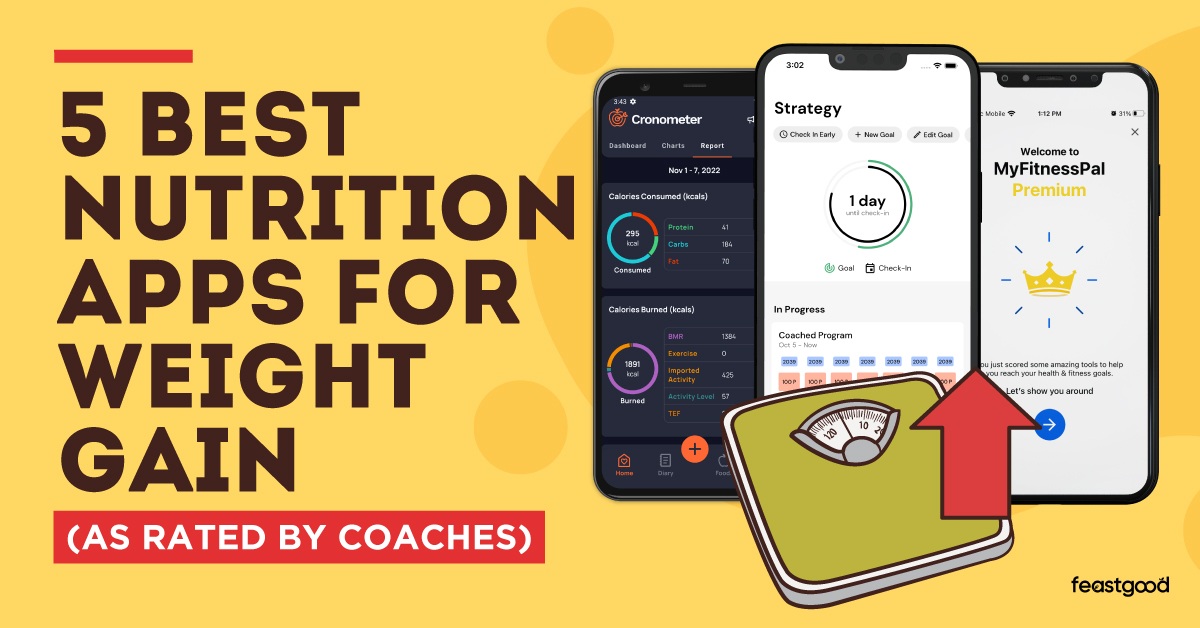Some links in this article are affiliate links, which means we earn from qualifying purchases. Learn more.
If your goal is gaining weight, you might feel frustrated and left out with many apps targeting losing weight. No worries, though, I got you. Our team at FeastGood.com has tested over 18 nutrition apps for ourselves and our clients with mass gain goals, and we’ve come up with the best picks (plus ones to avoid).
In A Hurry? Here’s Our Top Pick
Our top app for weight gain is MacroFactor. It dynamically adjusts your macros and calories according to your recorded progress. So, as you gain weight, your calories and macros change based on the most up-to-date science. Other apps claim to do this, but our tests showed MacroFactor to be the most accurate. Also, the app experience feels like working with a nutrition coach (without the cost).
The only downside to MacroFactor is that it doesn’t have a free version. However, when signing up, you get a 1-week free trial or two weeks free with the code FEASTGOOD.
Why Trust Our Recommendation?
I’ve used several apps to track my calories and macros for over eight years, adjusting them for different goals such as fat loss, muscle gain, weight maintenance, and sports performance, including competitive swimming, marathon training, CrossFit, and powerlifting.
Our team of nutrition coaches, registered dieticians, and personal trainers all have similar experiences, and we have collectively personally tested all of the apps on this list and collected user feedback from our clients.
At A Glance

Best Overall
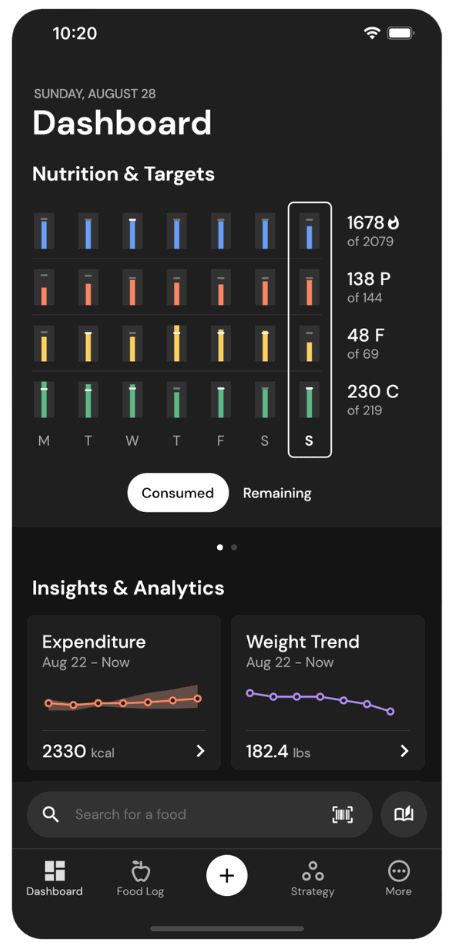
MacroFactor
Overall rating: 4.8 /5
• Calories
• Macros
• Micronutrients
• Progress photos
• Body measurements
• Body weight
• Body fat %
• Weight trends
Enter code FEASTGOOD when signing up to get an extra week on your free trial (2 weeks total). Cancel any time before your trial ends without being charged.

Best For Data Nerds
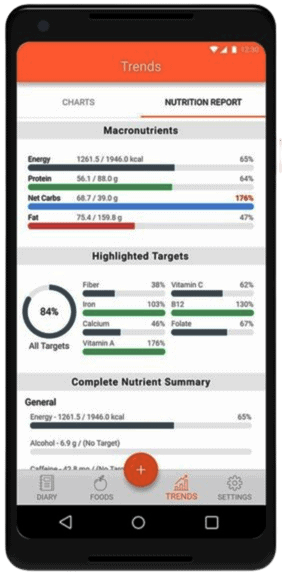
Cronometer
Overall rating: 4.4 /5
• Calories
• Macros
• Micronutrients (82)
• Water intake
• Weight
• Body fat %
• Measurements
• Health stats
• Sleep
• Exercise
• Bowel movements
*This link gets you 10% off the gold plan. No code is required.

Best For Those Who
Eat Out Often
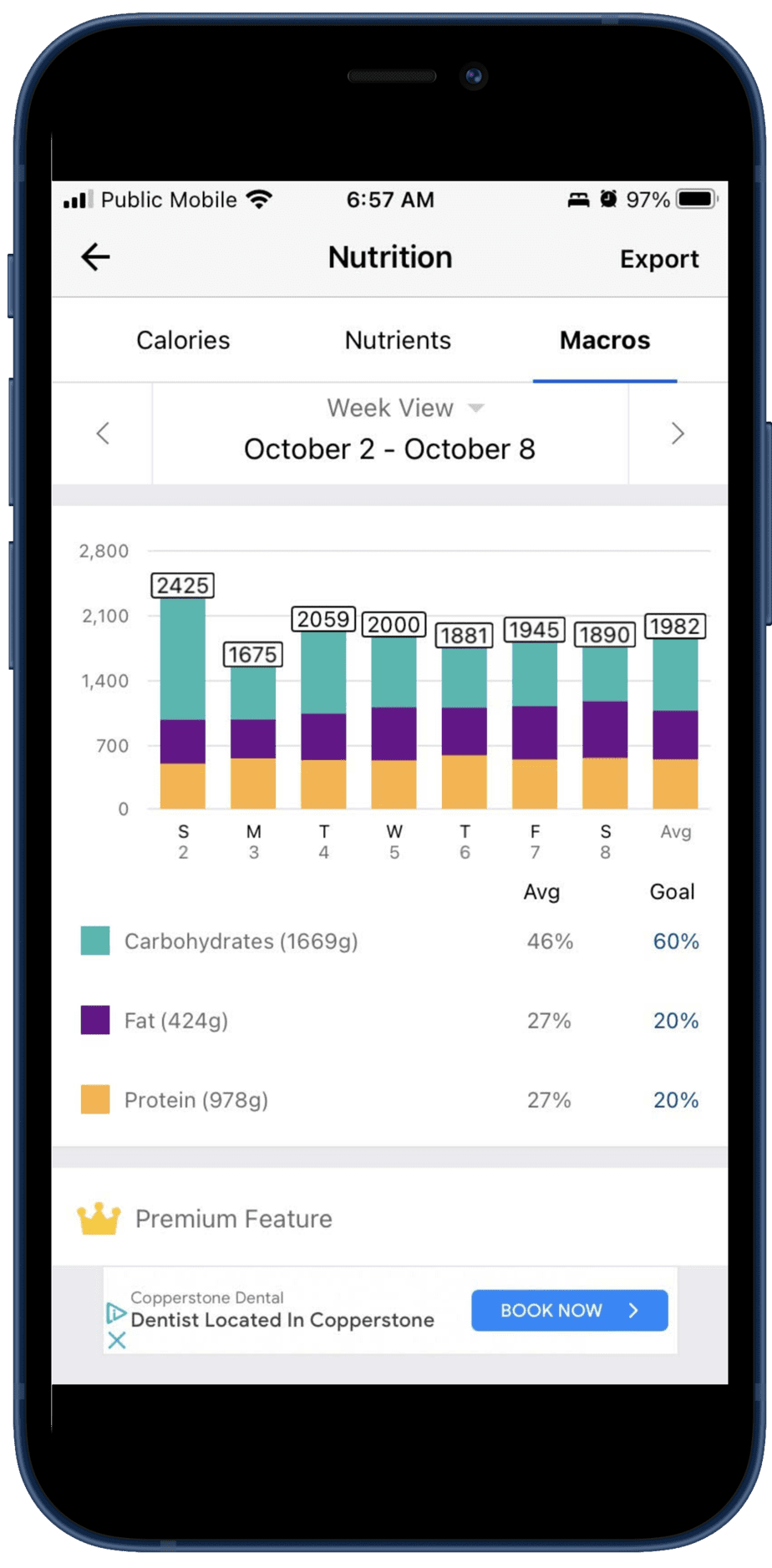
MyFitnessPal
Overall rating: 3.7 /5
• Calories
• Macros
• Limited micronutrients (6)
• Limited measurements
• Water intake
• Weight
• Body fat %
• Steps
• Exercise
Medical Disclaimer: The content of this article is provided for educational insights only. It should not be used as medical guidance. Individuals with a past of disordered eating should refrain from weight loss programs or calorie tracking. For medical advice, consult a certified healthcare professional. If you’re struggling with eating disorders, contact NEDA for assistance.

Key Criteria: How To Choose An App For Weight Gain
Below are the criteria we used to assess what makes an excellent app for weight gain.
Having Both Calorie And Macronutrient Targets That Are Accurate
Your calorie intake will determine whether you gain, lose, or maintain weight. But, the macronutrient breakdown of those calories determines how much of that weight is lean muscle mass vs. body fat. So, choosing an app that gives you both a calorie target AND an appropriate macronutrient split is essential to optimize your lean muscle mass.
Getting Personalized Adjustments To Calories And Macros
Since both calories and macronutrients are essential for muscle gain, the best apps for weight gain will provide you with suggested updates for both macronutrients and calories based on your progress to date.
Accurate And Verified Food Database
All of your work to hit your calorie and macro targets won’t be as helpful if the app’s food database entries aren’t accurate. Apps must come with food entries that are verified.
The Option To Have Recipes
A bonus feature is an inspiring recipe database so you don’t feel like you’re eating boring and/or bland meals to hit your targets. Having some delicious recipes to look forward to can make hitting your targets easier and feel less like a chore.
Various Measurement Recording To Track Progress
Keeping track of circumference measurements, body weight, body fat percentage, and progress photos is a great way to see whether you add muscle or fat. Only some apps offer the ability to track measurements.
RANKED: Top Apps For Weight Gain
- MacroFactor – Best Overall
- Cronometer – Best For Data Nerds
- MyFitnessPal – Best For Those Who Eat Out Often
- MyMacros+ – Best Basic Option
- RP Diet – Best For Strict Bodybuilders
1. MacroFactor – Best Overall
Overall rating: 4.8/5
MacroFactor is our #1 recommended macro-tracking app, which applies equally to weight gain and weight loss goals. This app is like having a nutrition coach in your pocket because it provides updated calorie and macronutrient targets based on weekly goals and results.
The app uses actual foods logged compared to weight and recorded measurements to provide weekly updated calorie/macro targets.
The app is designed to support long-term consistency, with some flexibility so that targets do not need to be hit perfectly each day, but rather paying attention to weekly average intake and weekly average weight.
While testing this app, our in-house nutritionist Amanda Parker couldn’t say enough good things about this feature. The app based its recommendations for updated inputs based on the foods that she actually logged, and her actual weigh-ins, as opposed to requiring her to hit precise targets.
As nutrition coaches, she and I often deal with an all-or-nothing mindset with our clients who feel they have to hit their targets perfectly or they might as well give up and not log at all. This feature in the app overcomes that and shows users they can make progress without being “perfect.”
Plus, Amanda was really impressed when the app was updated to include an option to save progress photos in the app. As they say, “A picture is worth a thousand words,” and this can be a really helpful visual marker of progress and body change when the scales aren’t moving.
I was personally really pleased to see the addition of waist-to-height and waist-to-hip measurements in the app, as markers of health that provide more insight than BMI (body mass index) measurements.
Check out our complete review of MacroFactor.
Highlights
- You get updated calorie & macronutrient targets adapted based on your results.
- You have access to a large verified food database.
- You are encouraged to focus on consistency over perfection.
Drawbacks
- You don’t get any workouts in the app.
- You have to pay; there is no free version of the app.
- You have to have a mobile device; there is no desktop version of the app.
Key Features
- You get custom calorie & macro targets that are realistic for sustainable progress.
- You can be sure that your intake is accurate because the food database contains only verified entries, which makes it easier to achieve your goals.
- You can easily & quickly log your foods using manual entry, barcode scanner, “AI describe” or recipes, making you more likely to stick with tracking your food and more likely to hit your goals as a result.
2. Cronometer – Best For Data Nerds
Overall rating: 4.4/5
Cronometer is the perfect app for data nerds. It’s for people who want and/or need to track the very finest details of their intake and results. The app tracks up to 82 micronutrients, making it perfect for people who need to monitor specific nutrients (such as sodium or cholesterol).
Cronometer’s extensive food database has a unique feature. When users submit entries for addition to the database, they are reviewed for accuracy, AND additional micronutrient information will be added based on lab-analyzed data for similar foods.
For example, suppose a user adds a brand name oatmeal and only 3-4 micronutrients are listed on the package label. In that case, Cronometer will automatically add the remaining micronutrient information for oatmeal based on lab-analyzed data for oatmeal.
I personally love this feature because I am tracking some micronutrients for my own health, but I want to be able just to scan the package label and not have to search for the “best” entry in the database with all of the micronutrient information – now I can trust the app to include that information for me.
Cronometer’s many reports can be customized and sent to healthcare professionals. It’s a great app for individuals working with coaches or other support personnel, especially because its suggested targets can be overridden entirely to match your healthcare provider’s recommendations.
I also use this feature to work with my own coach. I create a custom weekly report for him, and I can choose whether to include my supplements, biometrics information, and daily food logs. Cronometer generates a PDF with the requested information, and I email it to my coach.
The only downside is that Cronometer does not offer updated targets each week the way MacroFactor does. So you need either a coach to do this for you, or know how to make the adjustments yourself (which not everyone does).
Check out our complete review of Cronometer.
Highlights
- You can track a huge array of micronutrients.
- You can log blood test results and other lab results (e.g. blood pressure) along with body measurements.
- You can create custom reports and share them with your healthcare provider(s).
Drawbacks
- You don’t get automatically updated calorie and macronutrient targets.
- You can’t group foods into meals or snacks in the free version of the app – they appear as one big list.
- You can’t see the calorie and macro info for food when you search for it without clicking into the entry to see the details (not a huge drawback, but a slight nuisance).
Key Features
- You can record output metrics like blood pressure or cholesterol levels compared to input metrics like sodium intake in a custom graph to monitor the relationship over time, allowing you to decide what adjustments to make.
- You can easily share detailed information with your coach or other healthcare professional so that they can make the best possible plan to help you.
- You can record your sleep and mood so that you can optimize your recovery to get the most out of your training and nutrition to maximize your gains.
3. MyFitnessPal – Best For Those Who Eat Out Often
Overall rating: 3.7/5
MyFitnessPal is one of the oldest and longest-standing nutrition apps on the market today. The app has tried to adapt to keep pace with trends like the keto diet, but its functionality is now behind a paywall, meaning that there are other apps with the same or better functionality at a lower cost.
That said, the app is still in widespread use for a reason. It has a huge food database, and contains many more international entries and restaurant chain entries than many other apps.
I personally used the app when I was living overseas on an assignment in South Korea for three years, and I was impressed that I could scan Korean and other Asian food labels and still get results.
I also used the app for years, and it was the app I used when I embarked on my own mass gain journey in the fall of 2021 to focus on gaining muscle so that I could get even stronger and improve my performance in competitive CrossFit.
I input my own calorie and macro targets in the app, and increased them slowly each week while keeping an eye on my weight to ensure that it was increasing, but not too quickly, and also my performance in the gym.
(Note: While I did use it in 2021 if I was bulking today, I would choose MacroFactor now instead).
One downside to MyFitnessPal is the inaccurate food database. It loses major points for this.
It helped that I have a good background as a certified nutrition coach to identify which foods in the database were inaccurate. It would be harder for a beginner to know which entries to use and avoid.
Inaccurate calorie and/or macronutrient information can make it hard to progress toward your goals if you’re not sure you’re eating too much or too little.
Check out our complete review of MyFitnessPal.
Highlights
- You can find entries in the database for foods from all over the world, including many chain restaurants.
- You can set your own calorie targets, and the Premium version allows you to set macronutrient targets to the exact gram.
- You can access meal plans and recipes in the Premium version and log servings directly into your diary.
Drawbacks
- You need to have good background knowledge in nutrition to spot inaccurate entries.
- You can’t set macros by grams in the free version of the app.
- You have to pay for many features, including the barcode scanner.
- You have to put up with a lot of intrusive ads that make the app slow to use.
Key Features
- You can log foods in up to six meals or snacks per day, with calorie and macro targets displayed for each meal, allowing you to optimize how much you eat, and when.
- You can add exercise and/or sync exercise from other activity trackers/apps to line up your nutrition with your training.
- You can unlock features like tracking fasting or specific meal plans in the Premium version of the app.
4. MyMacros+ – Best Basic Option
Overall rating: 3.5/5
As its name suggests, MyMacros+ tracks macronutrients to help users achieve their goals, including weight gain. Like MacroFactor (our #1 pick), this app has a premium feature called Macro Coach, which provides weekly updated custom targets.
While this app is not our first choice for macro tracking, we consider it highly user-friendly for tracking (if you stick to basic foods).
You can easily change the serving size from cups to ounces to grams. I really like this feature because I don’t always have my food scale handy, and I might be estimating portions based on volume measurements like cups instead of knowing the exact weight in grams.
The app is quite detailed in its several settings for your activity level, your desired rate of weight gain, and your preference for low-carb/high-fat, or high-carb, low-fat, and high, low, or moderate protein intake.
This app is a solid choice for a clear, simple breakdown of calories and macros. If you’ve already got your workouts covered in another app or program and want a straightforward macro-tracking app for your nutrition, MyMacros+ is a good choice.
You can use the basic version if you’re working with a coach or other source for your targets, or you could pay a bit more for the MacroCoach option (but if you were going to do that, I’d probably recommend MacroFactor for just $2 more per month).
Check out our complete review of MyMacros+
Highlights
- You can easily log basic foods.
- You can set your own calorie & macro targets or pay for the Premium Macro Coach to suggest targets for you based on your progress.
- You can easily keep protein intake stable and switch the remaining calories between carbs and fats based on your preferences.
Drawbacks
- You have to pay for the app; there is no free version.
- You have to pay for an extra app (MyWorkout+) if you want to log your exercise.
- You can’t find many name-brand foods or restaurant entries in the database.
Key Features
- You can input your activity level and desired rate of progress to get different suggestions for your calories and macronutrients, allowing you to set the pace you want.
- You can create as many meals and/or snacks as you want, rather than having to stick to only 6 or 8 meals (the maximum in many other apps), so that you can accurately track your intake.
- You can use the Macro Coach feature if you’re not sure what your targets should be to continue your progress.
5. RP Diet – Best For Strict Bodybuilders
Overall rating: 3.0/5
The RP diet is “Renaissance Periodization.” They focus on nutrient timing and getting most of your daily carb intake before, during, and after your workouts to optimize performance and recovery.
The downside? The app is very rigid with setting macro targets for each meal.
Not only are macro targets set for each meal, but users must also check whether they hit the targets for each meal or were over or under. This level of rigidity makes the app unpopular with many people.
This feature was super unappealing for me because it made me feel like a failure if I wasn’t hitting my macros perfectly at every meal and snack, which made me want to give up rather than celebrate the success when I hit my targets in total for the day.
That said, those who can stick to the app’s recommendations see good results with their muscle gain goals. The app is designed with serious athletes in mind (whether recreational or competitive).
But, the app is less likely to provide a sustainable approach for most people in the long run.
Check out our complete review of RP Diet.
Highlights
- You can copy meals, which is helpful if you often eat the same things and saves time.
Drawbacks
- You can’t see a calorie total.
- You can’t track micronutrients, measurements, or body fat percentage.
- You have to hit your targets for every meal rather than the total day.
Key Features
- You can accept custom macro recommendations based on your weigh-ins compared to your compliance with the suggested macros to keep your progress on track.
- You can add foods to a shopping list to help simplify preparing your nutrition.
- Your carbohydrates are prioritized around your training sessions to optimize your performance and recovery, which are keys for gaining muscle.
Apps We Tested But Didn’t Make The Cut
BetterMe – Inaccurate Food Database & Disappointing Workouts
BetterMe is a nutrition and fitness app with a key focus on improving users’ relationships with food, fitness, and their bodies, and it boasts a workout library in addition to calorie and macro-tracking. That said, it is one of the poorer-quality apps we have reviewed in terms of its functionality.
We initially looked forward to including the BetterMe app in this listing because of its workout library, which is rare in nutrition apps.
However, our actual testing experience was not a good one: the app crashed frequently during workouts, and the workouts themselves were quite generic and did not provide enough progressive overload to lead to muscle growth.
The app was also quite disappointing in terms of an inaccurate food database and the ability to log foods in ounces, so we don’t recommend it even just for macro-tracking.
There are still use cases for BetterMe, but not regarding “weight gain.” You can read our full review of BetterMe here and who we recommend it for.
What Results Can You Expect From Using Weight Gain Apps?
The results you can expect when it comes to weight gain will depend on your starting point in terms of training age (the longer you’ve been training, the harder it is to make additional incremental gains), age (putting on muscle mass takes more work as you age), and hormonal status (male hormones are more naturally suited to gaining muscle).
Depending on these factors, gains can range from 0.5 to 2 lbs per month. No app alone will get you there, though. The best app for you will be the one that help you to be diligent in the following areas:
Calorie Surplus
To gain mass, you need to be in a calorie surplus.
It’s important for the app to be smart enough to continually adjust calorie and macro targets upwards to ensure that you’re truly in a calorie surplus and not just at a new higher maintenance level of calories.
Progressive Resistance Training
For your muscles to continue to grow, you need to train sufficiently hard to provide them with an anabolic (muscle-building) stimulus.
Over time, your body will adapt to a certain weight and number of reps for an exercise, and if you don’t increase the weight and/or reps, your body won’t have any incentive to put on additional mass.
An app that allows you to keep track of your sets, reps, and weights over time to ensure that you are progressing can be very helpful in ensuring that you are continuing to provide muscle-building stimulus.
A nutrition app likely doesn’t have features like this, so you might want to look for a dedicated training app to track your workouts.
Consistency
For a calorie surplus and a progressive resistance training program to work, they must be done consistently.
Occasionally having a calorie surplus, followed by days at or below maintenance, will not result in weight gain in the long term.
Training hard some days or some weeks, and then backing off the next, will not provide the consistent stimulus needed to force adaptations in the form of additional muscle tissue.
Apps that track streaks, send notifications for you to log in daily, and/or provide rewards or badges as incentives to stay on track with your plan can lead to better results if they get you more consistent with your nutrition and workout plan.
Planning
Hitting a calorie surplus, especially one with the correct macronutrient breakdown for optimal body composition, doesn’t happen accidentally.
Apps that allow you to pre-log your foods in advance (nearly all of them do), will allow you to plan your meals ahead of time so that you know what and how much to eat.
Of course, having this plan is pointless if you don’t actually have those foods on hand. The best apps will give you a shopping list of what you need to make your planned meals.
Food Quality
Food quantity is more important than food quality when gaining weight. It doesn’t matter how high quality your foods are if you’re not eating enough of them to be in a calorie surplus.
That said, you want to feel your best from the food you eat to maximize your training sessions and recovery.
So, apps that allow you to monitor your intake in terms of quality can ensure that you’re not short-changing yourself on micronutrients (vitamins & minerals) needed for health if you’re choosing processed foods more often to help with hitting your calorie target without feeling over-full.
Our Testing Methodology Explained
Before we create “ranked lists,” the team at FeastGood.com spends weeks and months testing various individual apps. You can view all of the nutrition apps we’ve tested on this page, which are complemented by a designated article and video of our experience.
After using the apps and testing their functionality across several criteria, we consider how each app might fare for a specific use case, such as weight gain. We collaborate with several team members, including Certified Nutrition Coaches, personal trainers, and Registered Dietitians.
We also recognize that technology changes quickly, and therefore, we periodically review our ranked lists to see if the order of the products should change or whether any new products should be added to the list, or existing products removed.
Furthermore, we solicit feedback from our various clients about the apps they are using so that we can learn what they like best and what works for them.
References
Yoo EG. Waist-to-height ratio as a screening tool for obesity and cardiometabolic risk. Korean J Pediatr. 2016 Nov;59(11):425-431. doi: 10.3345/kjp.2016.59.11.425. Epub 2016 Nov 18. PMID: 27895689; PMCID: PMC5118501.
UAB Department of Nutrition Sciences. Retrieved from https://www.uab.edu/shp/nutrition/
About The Author
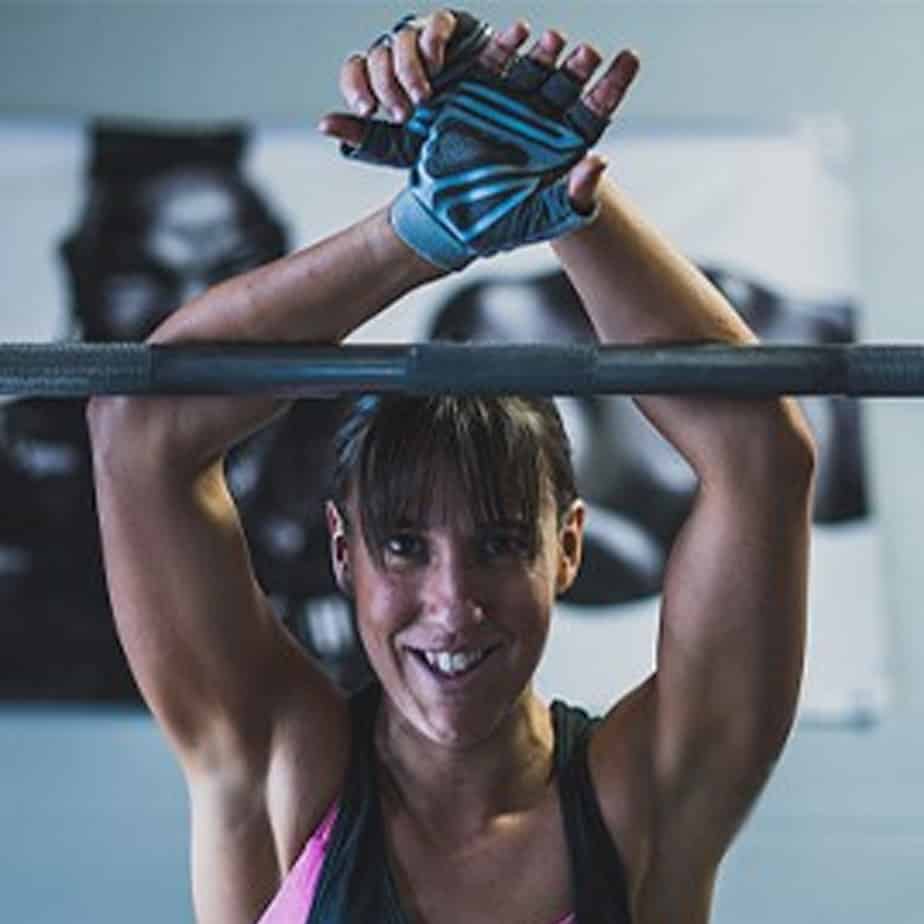
Lauren Graham is a Precision Nutrition Level 1 certified nutrition coach. She focuses on helping busy professionals balance healthy eating and purposeful movement. Lauren has a background in competitive swimming and is currently competing as a CrossFit athlete. She has a passion for training, teaching, and writing.
Why Trust Our Content

On Staff at FeastGood.com, we have Registered Dietitians, coaches with PhDs in Human Nutrition, and internationally ranked athletes who contribute to our editorial process. This includes research, writing, editing, fact-checking, and product testing/reviews. At a bare minimum, all authors must be certified nutrition coaches by either the National Academy of Sports Medicine, International Sport Sciences Association, or Precision Nutrition. Learn more about our team here.
Have a Question?
If you have any questions or feedback about what you’ve read, you can reach out to us at [email protected]. We respond to every email within 1 business day.
